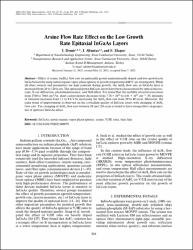| dc.contributor.author | Altuntaş, İsmail | |
| dc.date.accessioned | 2022-05-12T07:12:54Z | |
| dc.date.available | 2022-05-12T07:12:54Z | |
| dc.date.issued | 07.06.2021 | tr |
| dc.identifier.uri | https://hdl.handle.net/20.500.12418/12866 | |
| dc.description.abstract | Effect of arsine (AsH3) flow rate on epitaxially grown unintentionally doped and low-growth rate
InGaAs layer by using metal organic vapor phase epitaxy at growth temperature 640°C are investigated. While
all other sources and parameters are kept constant during growth, the AsH3 flow rate in InGaAs layer is
increased from 20 to 120 sccm. The epitaxial grown InGaAs layers have been characterized by optical microscopy,
X-ray diffraction, photoluminescence, and Hall effect. It is found that the mobility of carriers increases
from 3780 to 7043 cm2/Vs, sheet carrier density decreases from 7.74 × 1011 to 4.01 × 1011 cm–2, PL intensity
of emission increases from 1.1 to 8.6 V by increasing the AsH3 flow rate from 20 to 40 sccm. Moreover, the
same trend of improvement is observed on the crystalline quality of InGaAs layers with changing of AsH3
flow rate. The changing of AsH3 flow rate between 20 and 120 sccm is found to have strong effect on properties
of epitaxial InGaAs alloys. | tr |
| dc.rights | info:eu-repo/semantics/openAccess | tr |
| dc.title | Arsine Flow Rate Effect on the Low Growth Rate Epitaxial InGaAs Layers | tr |
| dc.type | article | tr |
| dc.contributor.department | Mühendislik Fakültesi | tr |
| dc.contributor.authorID | 0000-0002-3979-7868 | tr |
| dc.relation.publicationcategory | Uluslararası Editör Denetimli Dergide Makale | tr |















